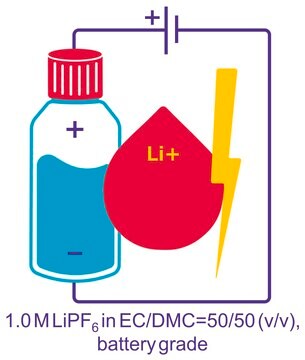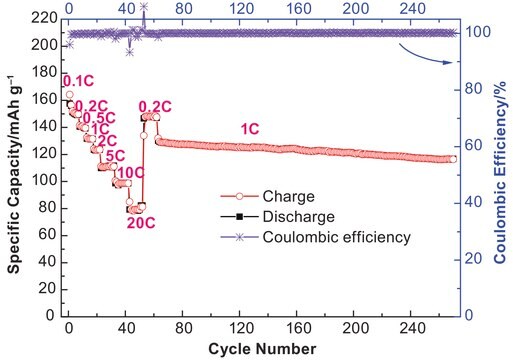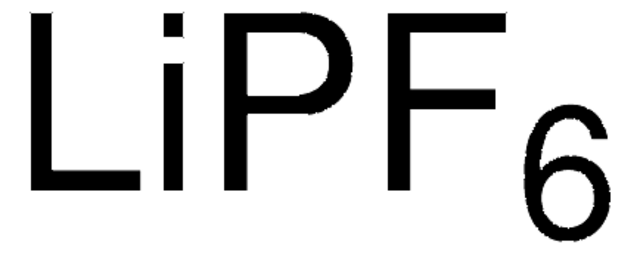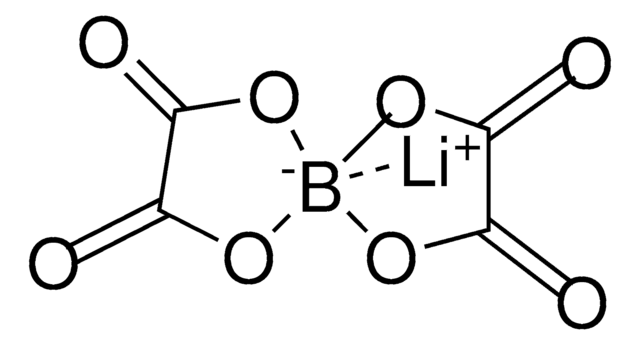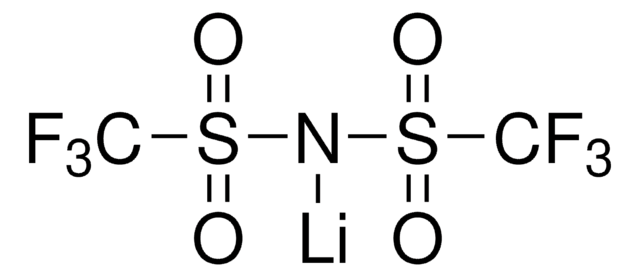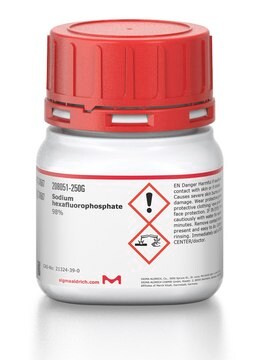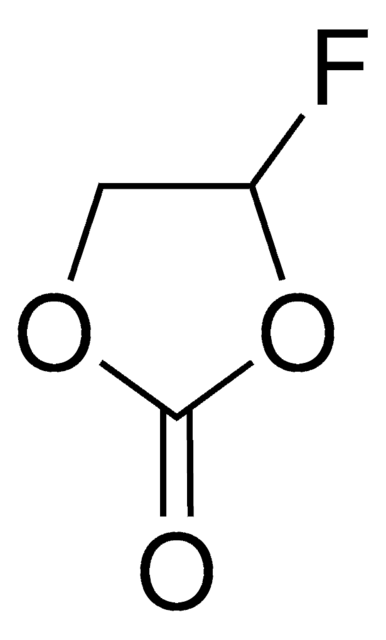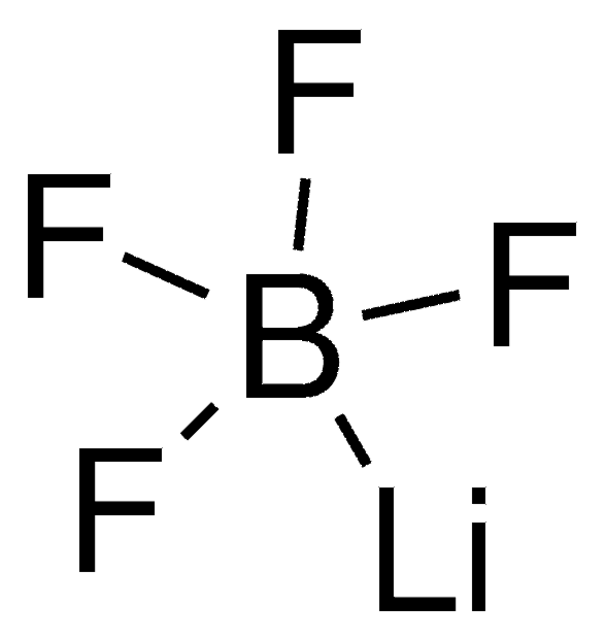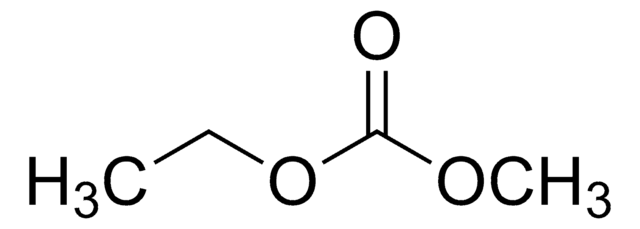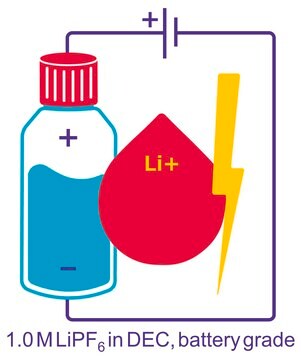Kluczowe dokumenty
450227
Lithium hexafluorophosphate
battery grade, ≥99.99% trace metals basis
Synonim(y):
Lithium phosphorus fluoride
About This Item
Polecane produkty
klasa czystości
battery grade
Poziom jakości
Próba
≥99.99% trace metals basis
Formularz
powder
charakterystyka ekologicznej alternatywy
Design for Energy Efficiency
Learn more about the Principles of Green Chemistry.
sustainability
Greener Alternative Product
zanieczyszczenia
≤100.0 ppm Trace Metal Analysis
mp
200 °C (dec.) (lit.)
Zastosowanie
battery manufacturing
kategoria ekologicznej alternatywy
ciąg SMILES
[Li+].F[P-](F)(F)(F)(F)F
InChI
1S/F6P.Li/c1-7(2,3,4,5)6;/q-1;+1
Klucz InChI
AXPLOJNSKRXQPA-UHFFFAOYSA-N
Szukasz podobnych produktów? Odwiedź Przewodnik dotyczący porównywania produktów
Opis ogólny
Zastosowanie
Cechy i korzyści
- Wyjątkowa czystość: Czystość ≥99,99% minimalizuje zanieczyszczenie metalami śladowymi, zapewniając przydatność w zastosowaniach wrażliwych nawet na drobne zanieczyszczenia.
- Stała wydajność: Bardzo wysoka czystość gwarantuje stałą wydajność w różnych zastosowaniach, zmniejszając zmienność i zwiększając niezawodność.
- Wzorzec o wysokiej czystości: Idealny jako wzorzec lub odczynnik do analizy metali śladowych i precyzyjnych technik analitycznych, zapewniając dokładne i wiarygodne wyniki.
- Klasa akumulatorowa do zastosowań w akumulatorach, zapewniająca przydatność i wydajność.
Inne uwagi
Preparation and characterization of lithium hexafluorophosphate for lithium-ion battery electrolyte.
produkt powiązany
Hasło ostrzegawcze
Danger
Zwroty wskazujące rodzaj zagrożenia
Zwroty wskazujące środki ostrożności
Klasyfikacja zagrożeń
Acute Tox. 3 Oral - Skin Corr. 1A - STOT RE 1 Inhalation
Organy docelowe
Bone,Teeth
Kod klasy składowania
6.1B - Non-combustible acute toxic Cat. 1 and 2 / very toxic hazardous materials
Klasa zagrożenia wodnego (WGK)
WGK 2
Temperatura zapłonu (°F)
Not applicable
Temperatura zapłonu (°C)
Not applicable
Środki ochrony indywidualnej
Eyeshields, Faceshields, Gloves, type P3 (EN 143) respirator cartridges
Wybierz jedną z najnowszych wersji:
Masz już ten produkt?
Dokumenty związane z niedawno zakupionymi produktami zostały zamieszczone w Bibliotece dokumentów.
Klienci oglądali również te produkty
Produkty
Increasing fuel costs and concerns about greenhouse gas emissions have spurred the growth in sales of hybrid electric vehicles (HEVs) that carry a battery pack to supplement the performance of the internal combustion engine (ICE).
Dr. Sun reviews the recent advances in solid-state rechargeable batteries and cover the fundamentals of solid electrolytes in solid-state batteries, the theory of ion conduction, and the structures and electrochemical processes of solid-state Li batteries.
Półprzewodnikowe akumulatory Li: Przegląd elektrolitów stałych, przewodzenia jonów, struktur i procesów elektrochemicznych.
Research and development of solid-state lithium fast-ion conductors is crucial because they can be potentially used as solid electrolytes in all-solid-state batteries, which may solve the safety and energy-density related issues of conventional lithium-ion batteries that use liquid (farmable organic) electrolytes.
Powiązane treści
Baterie, ogniwa paliwowe i superkondensatory opierają się na elektrochemicznym wytwarzaniu energii. Zrozumienie ich działania i separacji transportu elektronów/jonów.
Baterie, ogniwa paliwowe i superkondensatory opierają się na elektrochemicznym wytwarzaniu energii. Zrozumienie ich działania i separacji transportu elektronów/jonów.
Batteries, fuel cells, and supercapacitors rely on electrochemical energy production. Understand their operation and electron/ion transport separation.
Global Trade Item Number
| SKU | GTIN |
|---|---|
| 450227-5G | 4061832323695 |
| 450227-250G | 4061833398579 |
| 450227-25G | 4061832323688 |
Nasz zespół naukowców ma doświadczenie we wszystkich obszarach badań, w tym w naukach przyrodniczych, materiałoznawstwie, syntezie chemicznej, chromatografii, analityce i wielu innych dziedzinach.
Skontaktuj się z zespołem ds. pomocy technicznej